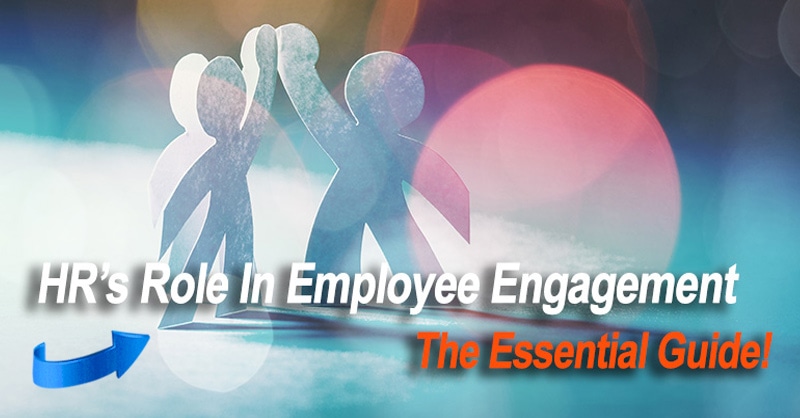Employee engagement means different things to different people. It’s an elusive concept which is why some organizations have struggled to embrace it whole-heartedly. Unlike other business terms like ‘accounts payable’, ‘outsourcing’ or ‘telecommuter’, there is no universally accepted definition of employee engagement. In this post, we provide a quick read definition of employee engagement. If you would like a more in-depth description of all of the different facets of employee engagement head on over to What Is Employee Engagement? The Ultimate Definition!
Organizational psychologist and academic, William Kahn, was the first person back in 1990 to try and define employee engagement. He described is as follows:
‘The harnessing of organisation members’ selves to their work roles; in engagement, people employ and express themselves physically, cognitively, and emotionally during role performances.’ – William Kahn
Since then thought leaders and business gurus have come up with various definitions, including the following:
‘Employee engagement is the art and science of engaging people in authentic and recognized connections to strategy, roles, performance, organization, community, relationship, customers, development, energy, and happiness to leverage, sustain, and transform work into results.’ – David Zinger, engagement speaker, coach, and consultant
‘Employee engagement is the emotional commitment the employee has to the organization and its goals.’ – Kevin Kruse, author
‘Employee engagement is characterized as a feeling of commitment, passion, and energy that translates into high levels of persistence with even the most difficult tasks, exceeding expectations and taking the initiative. – Linda Holbeche & Geoffrey Matthews, authors and business consultants
The Definition Of Employee Engagement
In the definition of employee engagement below, we have distilled the best bits of all those definitions out there and have come up with our own version. Ours is a simple, easy-to-understand explanation that cuts to the heart of what employee engagement is all about.
Employee engagement is the emotional connection employees feel to the company, its mission and values and it drives them to go above and beyond the basic requirements of the job.
It’s clear though, from the sheer number and complexity of definitions that employee engagement is a difficult concept. We would be doing it a disservice if we gave the impression that a one-sentence definition is the sum total of what you need to know.
In fact, there are plenty of misconceptions out there about employee engagement. So, let’s spend some time now looking at what employee engagement is not.
What Employee Engagement Is Not
Employee engagement is not employee satisfaction. It’s important not to confuse employee engagement with employee satisfaction. It’s a common mistake. Many people think that a worker who turns up and does their 9-5 hours, performs the job to a good standard, doesn’t complain and appears to be happy most of the time, has to be engaged, right? Well, they may well be satisfied with the job, but that doesn’t mean they’re engaged. You see, an employee who is merely satisfied won’t go the extra mile and put in that additional effort. An employee who is just satisfied won’t necessarily volunteer new insights and innovations. And if a headhunter were to call them up with an enticing offer from the competition, a satisfied employee is unlikely to show you any great loyalty.
Employee satisfaction is more of a transactional arrangement. If you as the employer fulfil your side of the contract by paying the employee on time, providing the necessary tools and resources and treating them with dignity and respect, then the employee will complete their side of the bargain. They will turn up to work, complete the contracted hours and get the job done to a reasonable standard. But that’s it. The satisfied employee has nothing really invested in the company or has any great emotional connection.
Employee engagement is not about employee happiness. In addition, try not to confuse employee engagement with happiness. Sure, your staff members probably love the free team lunches, subsidized gym membership and on-site yoga classes you provide. These perks and benefits may well help to make your team members happy at work and rate you highly as an employer, but making employees happy is different from making them engaged. Happy employees, or indeed satisfied ones, are not enough.
Engaged employees are those who feel energized about their work. They will go above and beyond without having to be asked and without expecting anything in return. Engaged employees tend to be more proactive, productive and positive. Quite simply, they will add value to any business.
Disengaged Employees
Before we move on to looking at why employee engagement matters, let’s first consider the issue of disengaged employees. Also known as ‘quitting in seat’, these workers may be physically present in the workplace, but have mentally checked out.
The latest research from Gallup tells us that an all-time high 34 percent of US workers consider themselves to be actively engaged at work. The trend has been slowly improving over a number of years now which is great news. However, the same research also tells us that 13 percent of the workforce are disengaged. And while that percentage is at a new low, it still represents a significant number of staff who are actively disengaged.
What’s the big deal? Every workplace has few serial complainers but you learn to manage it, right? Well, that might be true to some extent; however, when you consider that it’s estimated disengaged workers cost US companies up to $550 billion a year, you may want to think again.
Furthermore, rather like a virus or a cold the negative, unenthusiastic and complaining attitude of the disengaged employee has a nasty habit of spreading though the workplace. If not checked, you can quickly find yourself with a significant problem on your hands.
Therefore, instead of focusing all your corporate efforts on a program of employee engagement, you may also want to consider reaching out to disengaged employees. Ensuring that staff members who are perhaps currently just feeling slightly disgruntled don’t spiral down into the actively disengaged is well worth the effort.
Definition Of Disengaged Employees
Just as we’ve made it clear what we mean by employee engagement, let’s also set the record straight about disengaged employees. Here’s our definition:
‘Disengaged employees are those that have mentally checked out of the workplace. Lacking in passion, motivation, energy and creativity, they’re simply going through the motions in their job roles.’










0 Comments